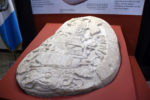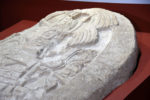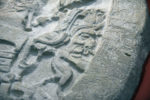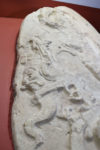 An engraved stone altar attesting to the political vicissitudes of 6th century Maya city-states has been found in La Corona, Guatemala. The limestone block is 4.8 x 4 feet and weighs close to a ton. It was discovered in the remains of a temple and can be precisely dated thanks to the inscription and the awesomeness of the Maya calendar to May 12th, 544 A.D.
An engraved stone altar attesting to the political vicissitudes of 6th century Maya city-states has been found in La Corona, Guatemala. The limestone block is 4.8 x 4 feet and weighs close to a ton. It was discovered in the remains of a temple and can be precisely dated thanks to the inscription and the awesomeness of the Maya calendar to May 12th, 544 A.D.
 The carved stone depicts a ruler of La Corona named Chak Took Ich’aak. His dynamic representation is on the top center of the stone. He holds a ceremonial bar, a symbol of leadership, shaped like a double-headed serpent. Emerging from each of the two heads are the patron deities of the city: Chak Wayis Chahk to the right, Yaxal Ajaw on the left side. On the right edge of the stone is a hieroglyphic inscription which includes the precise date. Lining the bottom edge is the head of a supernatural being adorned with aquatic plants.
The carved stone depicts a ruler of La Corona named Chak Took Ich’aak. His dynamic representation is on the top center of the stone. He holds a ceremonial bar, a symbol of leadership, shaped like a double-headed serpent. Emerging from each of the two heads are the patron deities of the city: Chak Wayis Chahk to the right, Yaxal Ajaw on the left side. On the right edge of the stone is a hieroglyphic inscription which includes the precise date. Lining the bottom edge is the head of a supernatural being adorned with aquatic plants.
 In 544, La Corona was ruled by the Kaanul kingdom, the powerful Snake dynasty that was then centered in the city of Dzibanche (the dynasty’s seat moved to Calakmul around 580-590). La Corona under Chak Took Ich’aak was one of Kaanul’s allies/vassal city-states. He was still king almost 20 years after the inscription was dedicated when in 562 Kaanul defeated its greatest rival, Tikal. When Tikal fell, Kaanul gained control over all of Peten.
In 544, La Corona was ruled by the Kaanul kingdom, the powerful Snake dynasty that was then centered in the city of Dzibanche (the dynasty’s seat moved to Calakmul around 580-590). La Corona under Chak Took Ich’aak was one of Kaanul’s allies/vassal city-states. He was still king almost 20 years after the inscription was dedicated when in 562 Kaanul defeated its greatest rival, Tikal. When Tikal fell, Kaanul gained control over all of Peten.
 Like the Centipede dynasty king K’inich Bahlam II who would rule El Perú-Waka 100 years later, Chak Took Ich’aak cemented his alliance and position by marriage to a princess from the Snake dynasty. Dynastic marriages were an essential tool in the Snake kingdom’s box, tying a panoply of Maya cities around Tikal to the dynasty and forming a sort of political and military cordon to support Kaanul’s final assault. The Snake lords ruled Peten for two centuries after that victory.
Like the Centipede dynasty king K’inich Bahlam II who would rule El Perú-Waka 100 years later, Chak Took Ich’aak cemented his alliance and position by marriage to a princess from the Snake dynasty. Dynastic marriages were an essential tool in the Snake kingdom’s box, tying a panoply of Maya cities around Tikal to the dynasty and forming a sort of political and military cordon to support Kaanul’s final assault. The Snake lords ruled Peten for two centuries after that victory.
[Tomas Barrientos, co-director of excavations and investigations], said the altar “fills in the gaps” and “pieces together the puzzle” of the Mayan culture’s political relationships.
“It’s a high quality work of art that shows us they were rulers entering into a period of great power and who were allying themselves with others to compete, in this case, with Tikal.”
La Corona “was the place where the most important historical Mayan political movement began to take shape.”